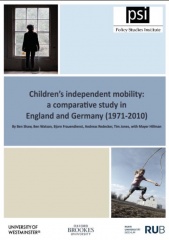Children's independent mobility: a comparative study in England and Germany (1971-2010)
Document types:
Document weight:
Document geography:
Geographical spread:
Children’s well-being and health, the quality of the environments they are brought up in and the impact of a range of social and technological developments in the lives of children has been the subject of much research, public concern and debate. This report presents new research on one factor that is affected by (and affects) these issues – children’s independent mobility. This can bedefined as ‘the freedom of children to travel around their own neighbourhood or city without adult supervision’ (Tranter and Whitelegg, 1994).
This report compares new findings with research that was undertaken 20 and 39 years before. In 1990, the Policy Studies Institute (PSI) published One False Move... A Study of Children’s IndependentMobility (Hillman, Adams and Whitelegg, 1990). The headline finding reported that, in England, between 1971 and 1990 there was a dramatic decline in children’s independent mobility. In 1971, 80per cent of seven and eight year old English children surveyed were allowed to go to school without adult supervision. By 1990, the figure had fallen to 9 per cent. Over the same period, in Britain, although the volume of traffic nearly doubled, child fatalities on the roads nearly halved (Hillman, Adams and Whitelegg, 1990: p3). Similar surveys were also conducted in West Germany in 1990. These found that German children in comparable areas had substantially higher levels of independent mobility, in spite of higher levels of car ownership.
The One False Move report challenged the orthodoxy that road casualty statistics represented a valid and reliable indicator of road safety. Fewer children were being killed and injured even though road traffic had increased. Rather, children had been removed from the source of danger – namely traffic– either through their denial of the freedom to play outside and travel in their local community unsupervised by adults or because they were taken by car rather than on foot or by bike. Clear evidence was presented that parents restricted their children’s independent mobility because of a fear of danger from traffic. A large increase in the time that parents spent escorting children to destinations was also noted, with the increase in car use for these journeys exacerbating the dangers posed to the remaining unaccompanied children and other pedestrians (Hillman, Adams and Whitelegg 1990: p106).
Twenty years on from the 1990 One False Move report, PSI, in conjunction with partners at Oxford Brookes University and Ruhr-Universität Bochum in Germany, has returned to this issue to examinethe changes in children’s independent mobility over nearly 40 years in England and over 20 years in Germany.

